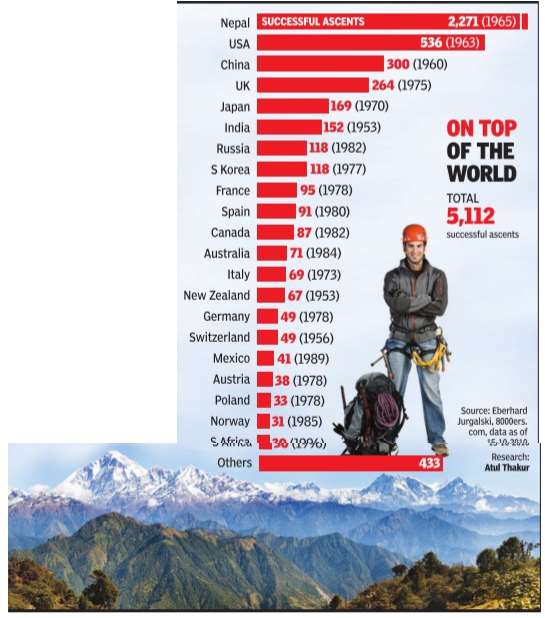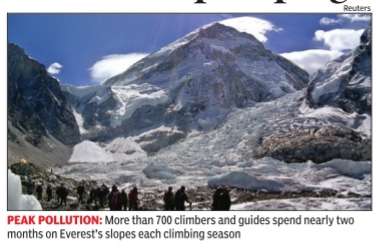Mount Everest
This is a collection of articles archived for the excellence of their content. |
Contents |
History
The Times of India, Jun 01 2015
Data analysis after Nepal quake shows Everest shrunk by 2.5cm
When was Mount Everest discovered?
In 1840s, Andrew Waugh, the British Surveyor General of India found a peak in the eastern end of the Himalaya. In 1852, Indian mathematician and surveyor Radhanath Sikdar calculated the peak's height and it was discovered that it was higher than Kangchenjunga -world's highest peak at that time.The mountain previously known as Peak XV was renamed Mount Everest in 1865 after Sir George Everest, British surveyor general of India from 1830 to 1843.
What is the height of Mount Everest?
The long accepted figure of the mountain's height was 29,028 feet or 8,848 metres. This figure was calculated by Indian government's 1952-54 survey . Since then there have been several at tempts to measure the mountain's height. In 1975 Chinese surveyors calculated that the height was 8,848.11 metres. Similarly an Italian survey using GPS and laser measurement yielded the figure of 8,846 metres by subtracting the height of the peak's ice cap. Until 1999 the value used by most researcher and mapping agencies was the figure es tablished by the Indian sur vey. In 1999, a US team using satellite technology ob tained a figure of 8,850 metres which today is the most accepted height of the peak. Analysis of satellite data after the recent earthquake in Nepal suggest that Everest might have shrunk by about 2.5 cm.
When did the ascents start?
It is believed that Clinton Thomas Dent, president of the Alpine Club which is the world's oldest mountaineering club was the first person to propose an ascent of Everest.
Above In his 1885 book ` the Snow Line' Dent wrote it was possible to climb the world's highest peak. The first highly publicized attempt to climb the peak was done in 1924 when British mountaineers George Mollory and Andrew Irving attempted to scale Everest. The expedition resulted in a disaster as they never returned. In 1999, Mallory's body was found in the mountain. It is uncertain whether they managed to reach the peak.After 29 years Sir Edmund Hillary of New Zealand and Tenzing Norgay of India set foot on Everest on June 29, 1953. As of 2010 more than 5000 people have climbed the mountain.
What are the difficulties in climbing Mount Everest?
Climbing Mount Everest is the ultimate test of human limitsboth physical and financial. The climb can take many days starting from the trekking to the base camp and then climbing up to three higher camps before the final summit attempt. Because of the high altitude the oxygen content of air is one third of normal level. Lack of oxygen and extreme cold has adverse effects on human body . Even simple calculation related to oxygen bottles and sense of direction becomes extremely complicated. The low temperature and unpredictable weather can cause frostbite leaving legs and hands useless.Blood becomes thicker and wounds take long time to heal. The climbers are on their own because hisher teammates usually don't have the strength to carry himher down in case of accidents. There have been many incidents where people have ignored a frostbitten disoriented climber.The climbing rout has lots of dead bodies. Various websites of agencies that organize guided climbing show that summit attempt may cost above Rs 40 lakhs.
Why do many mountaineers criticize commercialization of Everest climbing?
Guided tourist companies assure they can take anyone to the top if they can bear the expense. This has increased the number of attempts as well as death tolls to climb the mountain. Several people have died in the attempts and their dead bodies are left on the peak.It has increased pollution on Everest which is now bursting with the leftover oxygen canisters, broken climbing equipment, human waste and dead bodies. Recently the president of Nepal Mountaineering Association, Ang Tshering warned about the pollution caused by human waste which has reached critical levels and threatens to spread disease on Everest.
Human waste
Mountain of human poo plagues Everest
Kathmandu The Times of India Mar 04 2015
Human waste left by climbers on Mount Everest has become a problem that is causing pollution and threatening to spread disease on the world's highest peak, the chief of Nepal's mountaineering association said on Tuesday . The more than 700 climbers and guides who spend nearly two months on Everest's slopes each climbing season leave large amounts of feces and urine, and the issue has not been addressed, Ang Tshering told reporters. He said Nepal's government needs to get the climbers to dispose of the waste properly so the mountain remains pristine.
Hundreds of foreign climbers attempt to scale Everest during Nepal's mountaineering season, which began this week and runs through May . Last year's season was canceled after 16 local guides were killed in an avalanche in April.
Climbers spend weeks acclimatizing around the four camps set up between the base camp at 5,300m and the 8,850m high summit. The camps have tents and supplies but no toilets.
Mount Qomolangma
The Times of India, June 15, 2015
Mt. Qomolangma moves 40 cm northeastward in 10 years
Mount Qomolangma has moved 40 centimeters to the northeast over the past ten years, with its height increasing by three centimeters, the National Administration of Surveying, Mapping and Geoinformation said Monday.
Monitoring data collected by the department from 2005 to 2015 shows that the mountain has been moving at a speed of four centimeters per year and has been growing by 0.3 centimeters annually.
The Mountain is located on the collision belt for the boundary between the Indian and the Eurasian Plates, where the crustal movements are active. Geographical changes in the area have great influence on the climate, environment and ecology of East and South Asia, experts said.
The administration set a satellite monitoring system on Qomolangma in 2005 and started to observe the movement of the mountain.
Observers with the department found that Mount Qomolangma shifted three centimeters southwestward after the devastating Nepal earthquake on April 25,2015, while the height of the mountain was left unaffected.
Mountaineers to Everest

The Times of India, Jun 01 2015
Since its discovery, Mount Everest has always fascinated mountaineers from across the globe to reach the world's topmost point. When asked why he is climbing Everest, British mountaineer George Mallory had famously said, “Because it is there“. Mallory died in the summit attempt.In 1953, Edmund Hillary of New Zealand and India's Tenzing Norgay became the first humans to set foot on Everest's top. Tenzing's feat somehow did not popularize mountaineering in India the way New Zealanders got inspired by Hillary's achievement. As of the end of 2010's climbing seasons, Indians have successfully climbed the mountain 152 times -fifth highest in the world. Considering its small size, New Zealand's 67 successful attempts are commendable.
Safety issues
2018: safer, cleaner than before

ii) What is the height of Mt Everest?
iii) Indians on the peak;
iv) Women on the peak;
v) Cleanliness issues.
From: April 22, 2018: The Times of India
See graphic:
i) 1923-90, and 2000-17: deaths on the Everest;
ii) What is the height of Mt Everest?
iii) Indians on the peak;
iv) Women on the peak;
v) Cleanliness issues.
